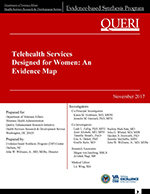
Investigators: Co-Principal Investigators: Karen M. Goldstein, MD, MSPH; Jennifer M. Gierisch, PhD, MPH
Co-Investigators: Leah L. Zullig, PhD, MPH; Suchita Shah Sata, MD; Amir Alishahi, MD, MPH; John D. Whited, MD, MHS; Timothy Brearly, PsyD; Hayden B. Bosworth, PhD; Eric A. Dedert, PhD; Jennifer McDuffie, MPH; Giselle Raitz, MD; John W. Williams, Jr., MD, MHSc
Download PDF: Complete Report, Abstract, Report, Appendices
Telehealth encompasses a variety of technologies and approaches to connect individual patients to health care resources with the goal of delivering the right intervention to the right patient at the right time. The Department of Veterans Affairs has been on the forefront of implementing telehealth solutions as a way to extend care to key populations of interest or to overcome barriers to receiving timely and high-quality care. Women Veterans are one such key population who could benefit from the flexibility and access afforded by telehealth because they are geographically dispersed within the Veterans Health Administration and have gender-specific care needs. Thus, the goal of this report was to conduct an evidence map that characterizes the quantity, distribution, and characteristics of evidence which assesses the effectiveness of telehealth services designed specifically for women.
What are the quantity, distribution, and characteristics of evidence assessing the effectiveness of telehealth services designed specifically for women?
Telehealth Services Designed for Women (Management eBrief)
Goldstein KM, Zullig, LL, Dedert EA, et al. Telehealth Interventions Designed for Women: An Evidence Map. Journal of General Internal Medicine. Published online October 3, 2018. https://doi.org/10.1007/s11606-018-4655-8.